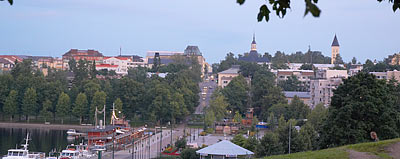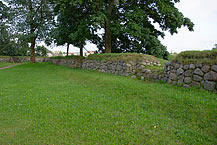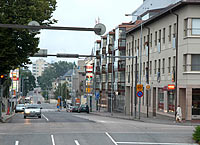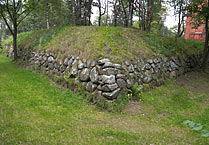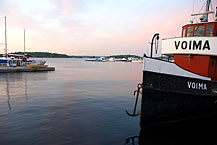Villmanstrand - Lappeenranta Fortress history
The crash is heard in Villmanstrand,
And shine of bloody swords is seen.
<...>
The Swedes are beaten and try to fled
The Russian horsemen rush to them
Through bloodless heaps of foe's corps
In ditch of fortress Villmanstrand
They trample the countless Swede's heads...
M. Lomonosov, "Loyal occasional ode", 1741.
First settlements appeared here just after the Ice Age. There was well known trade place Lapvesi at the cape where now the fortress is.
The city charter was signed by Sweden Queen Christina in 1649. There were only 200 residents in the town at that time. Governor Count Peter Brahe was initiator of that. The new city got the name Villmanstrand (Wild man coast) and municipal arms with a wild looking unshaved man with a big cudgel.
In 1701-21 big Sweden-Russian war - North War or "Great Wrath" broke out. The Vyborg was seized by Russians in 1710 and Villmanstrand was evacuated in the same year. Since 1721 the Villmanstrand become important Sweden border fortress. German engineer Iogan Faber made a first blueprint of the town's fortifications. Bastion's front was built in 1720-th. The city was populated with 300 residents and a hundred soldiers. In 1730-th the gates were built, and new bulwarks were made.
In 1741 a new war with Russia begun - so-called "Lesser Wrath" or "Hat's War". There were near to 600 residents in the city at that time. In the war's eve, colonel Gustav von Villebrant with infantry regiment and artillery company arrived to the city. August 22 corps under command of major-general Vrangel (3000 men) marched from Tavetti area. They come into position to surround Myllymaki hill just before the main bulk of Russian army under Field Marshal Peter de Lassi (near to 10000 men) appeared on the scene.
Russians attacked at once but got an envelope of fire from Myllymaki hill and from the town's bastions and were forced to retreat with considerable loss. They understood where the key point of the defense was, attacked the Myllymaki positions and after three hours fight whipped Swedes out from the hill and seized their guns. After that, attack to the town was resumed. Swedes Commander-in-Chief Wrangel was wounded in that fight. New commander colonel Willebrant gave an order to surrender the fortress, but Russian officers with a flag of truce were shot near to the fortress gates. New fierce storm begun and bloody massacre was made by Russians after that so few Swedes soldiers and civilians could flee away through the Saima lake.
General Wrangel was captured and after return to Stockholm was rewarded, but colonel Willebrant was condemned and executed. Villmanstrand was ruined and all its survivors were deported to Russia.
Since 1743 Villmanstrand become border city of Russian Empire. New residents were transferred from Vyborg vicinities. In 1740-th, Nikolaevsky redoubt was erected upon Myllymaki hill. The town's fortifications were renovated, and new bulwarks were built at the south part of the fortress. There was a border strong point and Saimaa fleet naval base.
In 1791 famous Russian general Alexander Suvorov lived in Villmanstrand few months while superintended its fortification's construction. Emperor Alexander I visited the town in 1803. There was a considerable fortress at that times with numerous garrison's buildings inside of bastion's line. All civilians were evicted from the fortress to the forstadt at the south side of the fortress's cape.
After the war of 1808-1809 all the Finland was included into the Russian Empire for the "perdurable term" and the fortress has lost its military value. There was the small garrison still. In 1885 and 1891 Emperor Alexander III visited the fortress.
In 1819 the female prison was established in the fortress. Its convicts were condemned for infanticide, mostly. In 1881 the female prison was transferred to Hamenlinna and a male prison was established in a new build three-floor brick corps. The prison zone was enclosed by high wooden fence. "Reds" Finns were enclosed here after the Civil War in Finland in 1918. Some of them were executed on the north slopes of the fortress cape, and there is a monument near to the South Karelia Museum's building. In 1950-th prison's building was dismantled during the city reconstruction.
Lappeenranta - Villmanstrand was heavily pounded by Soviet aviation during the Winter War (Talvisota) and Continuation War (Jatkasota) but fortress was not affected.
Impressions
This is, in a manner of speaking, a classic bastion's fortress of northern style (northern fortress). I even did not notice it at first. There are numerous history landmarks, but they not strike the eye. You need to be calm and pacificated and do not hurry up. Latest evening or even white summer night could be the best time for the visit. Do not forget to possess one-two bottles of Lapin Kulta beer. It will be needed for your farewell meditation at the splendid Saima lake beach, at the time when the gold northern sun dives to the still lilac Saima's water...
Land forts and fortress:
Bip Castle Gatchina Ivangorod Izborsk Kexholm Kirillov Monastery Koporye Novgorod Pechorskiy Monastery Peter&Paul Fortress Porkhov Pskov Schlisselburg Staraya Ladoga Tikhvin Vyborg Hameenlinna Hamina Kastelholm Kymenlinna Lappaenranta Raseborg Castle Savonlinna Tavetti Turku Visby Fredrikstadt Fredriksten Hegra Fort Hoytorp Fort Arensburg Narva Tallinn Antipatris Caesarea Jerusalem Latrun Fort Masada
Sea forts and fortresses:
Alexander Fort Ino Fort Krasnaya Gorka Fort Kronstadt: Kotlin isl. Kronstadt: North Forts Kronstadt: South Forts Trongsund Hanko Svartholm Sveaborg Marstrand Siaro Fort Vaxholm Oscarsborg
Artillery batteries and individual guns:
Coastal Artillery Hemso Fort
Fortified areas and defensive lines:
Karelian Fortified Area (KaUR) KrUR Leningrad Mannerheim Line Nevsky Bridgehead VT Line Harparskog Line Salpa Line Gothland
Russian
S e a r c h All news

